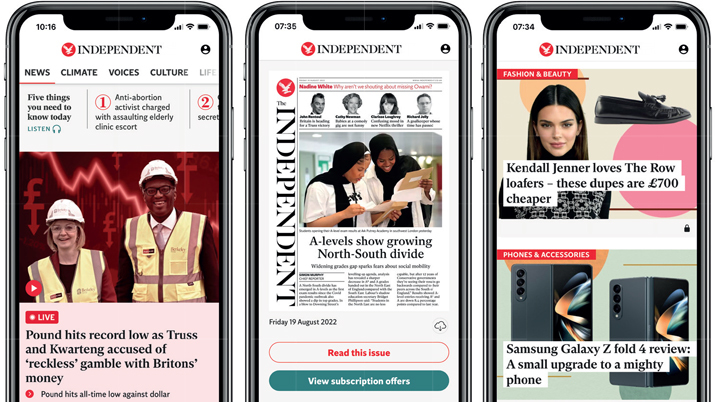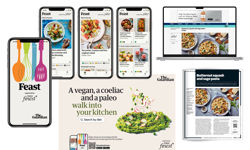
Apps are an increasingly important part of any news brand’s offering, but until earlier this year, readers of The Independent visiting the app store were faced with two different options leading to potential confusion. Now, the digital only newspaper has introduced a single destination app with new features, to encourage more people to sample its product, register and hopefully turn into paying subscribers.
Jo Holdaway, chief data and marketing officer for The Independent, explains that the brand’s first foray into the app space came when it retired the print version of the newspaper and became digital only.
“We had a small group of very loyal readers, and they were distressed that the newspaper was being retired, so we moved them across to the Daily Edition which is a smart digital version of the newspaper. It still has the front covers, you can swipe through, and it’s carefully curated by the editors, it gave them a lovely experience. We’ve kept 90% of that original cohort and they’re still avid readers of the Daily Edition and they read it like a newspaper from cover to cover. That is a particular way of consuming an app.”
When the Independent Minds subscription service was launched, they introduced another app to cater for that market which you could only access if you were a subscriber. This was more like a traditional app in terms of live feeds and news.
“What we then had was two apps in the app store, so our readers were becoming a little bit confused as to which they wanted, and we were cannibalising ourselves. We wanted to simplify the position,” explains Holdaway.
Unveiling the new app
The Independent app launched in May 2022 and is free to access, but with a meter after which you hit a paywall. The Daily Edition can still be accessed within the app and there are some areas which are premium content only.

“The rationale behind it was to simplify the proposition, to make it really good value and to try and get sampling up so people became aware of what we had in that new app.”
Premium content behind the paywall includes long reads, investigative journalism, Politics Explained and “anything that’s an Independent voice that you can’t get anywhere else”. In addition, a new feature available only to paying subscribers is audio versions of articles, which are currently provided by an automated service, but in the future, could be read aloud by journalists. The rest of the app including videos from Independent TV, is free.
The meter is currently set at 25 articles, but Holdaway and her team hope to make it a dynamic meter in the future, meaning readers will be able to access fewer articles before being asked to pay.
“What we’re trying to do is form a habit. We want to serve our content to readers wherever and whenever they want to consume it, that’s still our North Star, but we want to engender that loyalty, repeat visit and engagement,” she says.
First party data
When readers install the new app, they go through a registration process, to get them used to the idea of a value exchange in return for news. This is more important than ever with the demise of third-party cookies.
Holdaway says: “As chief data and marketing officer, I’m benefiting because I’ve got my first party data collection strategy and registration is the key area for that. We get to know our readers much better, and we can communicate with them if they opt into marketing comms and then they can start that user lifecycle journey with us.”
In the first couple of months after the app’s roll out, The Independent saw a significant number of people reaching the meter limit every week.
“They’re sampling all we have to offer for free and hitting the paywall much more often than they would have on the old app which is really good news, so we’re getting that habit forming and we’re getting the engagement.”
This has given them confidence to test changing the meter by giving app users fewer articles to read before they bump up against the paywall. They have done modelling which helps to identify users and their state depending on what articles they have read recently, the volume they read and how often they return.
“What in an ideal world we’d like to do is a dynamic meter so that we ask readers in the right state to pay for the content, when we know they’re the most engaged and they’re at that tipping point to subscription.”
Although targets are confidential, the strategy is to encourage as many people as possible to install the app so they can sample what The Independent has to offer, rather than simply pursuing subscribers.
“It’s not about install the app and subscribe, it’s install the app and look at the array of content and quality you can get. It’s all about encouragement and habit forming,” says Holdaway.
The Independent has more than doubled its user base since the new app launched, with new users up 300%. The wider registration strategy including the website is to bring in 2.5million new registrations over a 12-month period, and they aim to move a good proportion of those onto the app.
New features on the app include ‘Five things you need to know today’, curated by the Premium Editor which scrolls across the top of the screen. One of the most requested features by readers was dark mode, making evening reading or browsing easier on the eye. There is also a new interface and when the designers were creating it, they were told they didn’t have to use the designs from the old app experience.
“I think that’s quite freeing in terms of what would be the best experience for our readers rather than having to build upon something that’s a legacy experience,” says Holdaway.
Independent TV is one of the key pillars for expansion and users can access as many videos as they like for free on the app. The video strategy, led by MD Christian Broughton, offers strands of programming for sponsorship, including ‘Binge or Bin’, a new series about what shows are coming up on Netflix and whether they are worth watching or not.
US expansion
The US is another area targeted for expansion, with plans to introduce a US facing version of the app. A third of The Independent’s reader base is in the US, making it the company’s second most important market and the expectation is that it will soon be vying with the UK commercially.
“The US in terms of subscriptions is our next focus, so we will be concentrating on that over the next 12 months. We want to make it as relevant and pertinent and compelling to the US audience as the app we have here is facing the UK and European audience, then put the marketing and data resources behind that to try and get as many registrations as possible,” reveals Holdaway.
Could apps one day become the main way in which readers access news? Holdaway believes they are a growing and important part of the mix alongside the website and off-platform programmes with the likes of Facebook, Microsoft, Yahoo and Google, but she doesn’t think the app is going to replace these other modes of news content delivery any time soon.
“I think people still like to have the choice, depending on where they are, what they’re doing at the time and how much time they’ve got to read.”
One area they are looking at is how to monetise the app besides subscriptions and although they don’t currently have any advertising within the app, that will change in the future.
“It will be a very different advertising experience to web. There will be limited ads of higher quality in there,” she reveals.
Collaborative approach
As chair of the Association of Online Publishers (AOP), Holdaway is heartened by the collegiate atmosphere between premium digital publishers in the UK.
“We’re competing with not only the social media giants, but also Spotify and Netflix and everybody else for attention and time. If you’re comparing the digital space from a publishing perspective, everybody is very eager and keen to be collaborative and that’s a positive thing.”
First party data is a topic that premium publishers are keen to talk about and share information on, learning from the mistakes and successes of others to enable them to foster trust in their relationships with readers.
“Ultimately, it’s not about sending consumer data to a whole myriad of different vendors without their knowledge, it’s about responsibility, accountability, trust and that reader relationship.”
The detailed understanding of data her team has built up has been invaluable in the process of building an app from scratch, allowing them to focus on the metrics that matter.
“We know what works well in web and mobile web, so we’re trying to focus on those metrics which we know will move the dial in app rather than trying to look at everything at the same time.”
Holdaway started her career in print advertising, before moving into digital in 2005 for The Independent and the Evening Standard. Ten years ago, she moved to work for The Independent’s chief executive Zach Leonard building a data team, which began with one person and now comprises almost 40 people covering newsroom analytics, reader revenues and subscription strategy.
“I’m finding it probably the best job I’ve ever had in terms of intellectual stimulation, but I’m still a salesperson at heart, which I think really helps, because it enables you to identify what the business imperatives are and supply recommendations, insights and solutions. That’s what I find really satisfying.”
This article was first published in InPublishing magazine. If you would like to be added to the free mailing list to receive the magazine, please register here.












